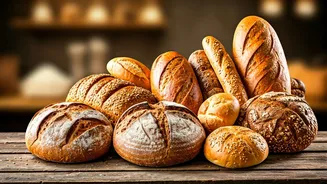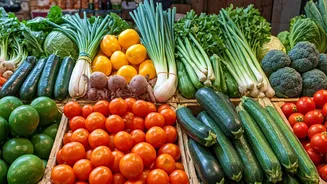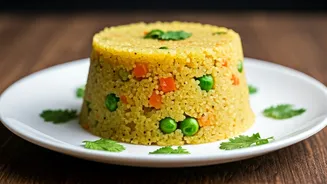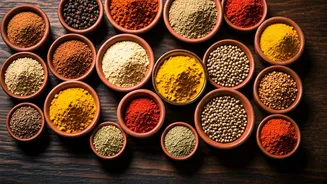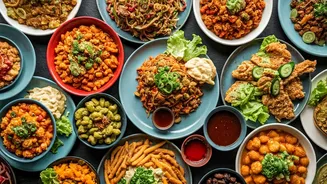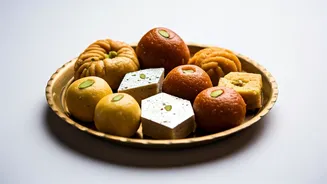Bread's Global Embrace
Bread, a staple food worldwide, holds significant cultural importance. Its presence varies dramatically across different regions, with each locale presenting
unique recipes, preparation methods, and accompanying traditions. The ingredients used also reflect local agricultural practices and climate. The methods of cooking and the flours used contribute to the distinct flavor profiles and textures found in bread around the globe. This range highlights how bread acts as a canvas, reflecting the tastes and practices of diverse societies. The history of bread shows its capacity to adapt and evolve, becoming a core component of daily diets and celebrations. Therefore, when appreciating World Bread Day, it's really about recognizing bread's many forms and its pivotal role in the human diet, reflecting a rich tapestry of cultural heritage and culinary creativity that has been evolving over thousands of years.
The French Baguette
The French baguette, instantly recognizable, is a long, thin loaf famous for its crusty exterior and soft interior. Traditionally, this bread is made with just flour, water, yeast, and salt. Its simple composition belies its complex flavor, developed through the process of fermentation and baking. The strict regulations in France define the characteristics that a baguette must adhere to in order to bear the name, ensuring consistency. Baguettes are considered a staple in French cuisine, frequently enjoyed with various dishes or simply on their own, often paired with butter or cheese. The baguette's simplicity combined with its satisfying texture and taste has made it an emblem of French culture and a beloved bread globally, perfect for various meals, from breakfast to dinner. Its preparation, which often involves a carefully maintained sourdough culture, highlights the artistry involved in baking this seemingly simple bread.
Italian Ciabatta
Ciabatta, another well-known bread, originated in Italy and is known for its chewy texture and irregular shape. The bread is characterized by a high water content, giving it a porous crumb and a slightly open structure. Ciabatta is typically made with wheat flour, water, olive oil, salt, and yeast, with the addition of olive oil adding both flavor and moisture. Its rustic appearance and delightful texture make it a versatile bread, suitable for sandwiches, dipping in olive oil, or accompanying Italian meals. Ciabatta's history tells of its relatively recent creation, developed as a response to the demand for a distinct Italian bread. This type of bread offers a contrast to the dense loaves common at the time. With its blend of simplicity and character, ciabatta showcases the Italian skill in producing bread that is both delicious and adaptable, further emphasizing the global reach and adaptability of bread.
German Pretzel
Pretzels, particularly the soft pretzels of Germany, have a unique appeal, known for their distinctive shape and savory flavor. The characteristic brown crust and chewy texture of pretzels arise from a pre-baking dip in a lye solution. This process not only provides the crust but also imparts a distinctive alkaline taste. Pretzel recipes generally involve wheat flour, water, yeast, and salt. They frequently feature a dusting of coarse salt. Found at festivals, markets, and bakeries throughout Germany, pretzels are a beloved snack, often accompanied by mustard or cheese sauce. They're a symbol of German culinary heritage. The method of making pretzels, using lye and baking to develop their texture, separates them from other kinds of bread, creating a food item that is both enjoyed and visually distinct within the world of bread.
Indian Naan Bread
Naan, a staple in Indian cuisine, is a soft, leavened flatbread that is usually baked in a tandoor, a traditional clay oven. Made with wheat flour, yeast, yogurt (or milk), and sometimes other ingredients like garlic or butter, naan offers a unique taste profile. The high-heat environment of the tandoor gives naan its signature blistered surface and fluffy texture. It has become a crucial element of Indian meals and is often served alongside curries and other flavorful dishes. Naan is a perfect example of how cooking techniques, like the use of a tandoor, affect both the taste and texture of a food. Its widespread consumption indicates how adaptable bread can be. It mirrors the variety of culinary practices and ingredients used throughout India, symbolizing the cultural richness and diverse influences that characterize Indian food.
Mexican Tortilla
Tortillas are a cornerstone of Mexican cuisine. They come in two primary types: corn tortillas and wheat tortillas. Corn tortillas, made from masa harina (specially treated corn flour), have a traditional flavor and texture, used for tacos, enchiladas, and other dishes. Wheat tortillas, made with wheat flour, water, and fat (like lard or oil), are softer and more flexible, commonly used for burritos and quesadillas. Both varieties are typically cooked on a griddle or in a dry pan. The history of tortillas reflects the long-standing use of corn in Mexican cuisine, dating back thousands of years. Tortillas are not just a side dish, but a foundation for many meals. They exemplify the capacity of bread to serve as a base for diverse dishes, providing a canvas for numerous fillings and flavors, and playing a vital part in Mexican cultural eating practices.
Ethiopian Injera
Injera, the spongy flatbread of Ethiopia, is made from teff flour, a grain native to Ethiopia. This sourdough bread has a unique tangy flavor and a porous texture, ideal for soaking up the flavorful stews and sauces common in Ethiopian cuisine. The fermentation process is critical to creating Injera's distinct qualities. It often requires several days, producing the bread's characteristic sourness and structure. Injera serves not just as bread but also as both a plate and an eating utensil. Ethiopian meals are often served on a large piece of Injera, with various stews and dishes placed on top. Its texture allows it to absorb the flavors of the accompanying foods. Injera embodies Ethiopian cultural practices, reflecting regional food availability. It highlights the unique preparation methods and the integration of food into social rituals. The reliance on teff, a locally grown grain, further links Injera to Ethiopian history and heritage.
Japanese Shokupan
Shokupan, a Japanese milk bread, is known for its incredibly soft, fluffy, and slightly sweet texture. This bread is made with ingredients like milk, cream, and butter, contributing to its rich flavor and tender crumb. The process often includes a tangzhong method. This involves cooking a portion of the flour with liquid (usually milk or water) before adding the rest of the ingredients, giving the bread its signature softness and longevity. Shokupan is a staple for Japanese breakfasts, often eaten toasted with butter or jam, or used in sandwiches. Its softness and mild flavor make it a versatile bread. Shokupan has become increasingly popular around the world, reflecting the global appeal of Japanese cuisine and baking. Its preparation shows how ingredients and techniques combine to create a distinct and pleasant eating experience, illustrating how bread adapts to meet particular cultural preferences.
Jewish Challah
Challah, a braided bread traditionally eaten on the Sabbath and Jewish holidays, is a rich and eggy bread, offering a slightly sweet flavor and soft texture. It is made with wheat flour, eggs, yeast, water, and sometimes honey. The eggs and honey contribute to the bread's richness, color, and flavor. Challah is often braided, with the number of strands varying, symbolizing the traditions and the significance of the occasions. The golden-brown crust and soft interior make it both appealing and delicious, often served with meals or on its own. It's a key part of Jewish culture. Challah showcases the deep connection of food to religious customs and historical heritage, highlighting the role of bread in Jewish culture, with the braiding representing the beauty of the traditions. Its symbolism further enhances the cultural significance, displaying how food practices reflect and reinforce cultural identity.
Global Bread’s Legacy
The journey through these bread types from around the world highlights how bread represents more than just a staple food. It symbolizes cultural heritage, culinary innovation, and the adaptability of human societies. From the crusty baguettes of France to the spongy Injera of Ethiopia, each bread provides a unique eating experience. They also offer a taste of history and traditions. World Bread Day celebrates this global diversity. It encourages appreciation for the skill and creativity involved in baking. The production of bread illustrates how local resources, preparation methods, and cultural preferences shape both the taste and role of bread in daily life and special events. This celebration of bread is a continuous story. It highlights the enduring importance of this simple yet complex food in human culture.
